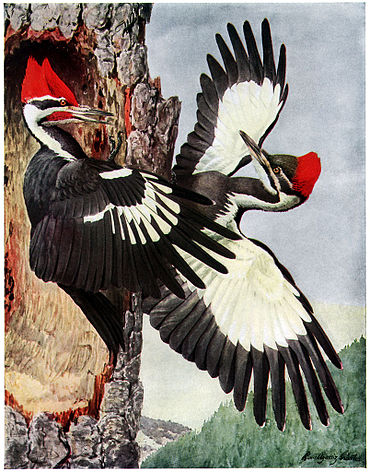Template:Species-2012-07-1
Species of the month
[edit]Pileated Woodpecker
[edit]Some facts on this bird:
Head and body length: 41 to 48 cm.
Wingspan: 66 to 76 cm.
Weight: 250 to 350 gr.
Habitat: Prefers primary, native montane and lowland Atlantic forest.
Range: Across Canada, the eastern United States and parts of the Pacific coast.
Diet: Insects, preferably carpenter ants; occasionally fruits and nuts.
Conservation status: Least Concern (IUCN 3.1).
First described: By Swedish naturalist Carolus Linnaeus in 1758.
Hammering sounds in the forest may not be wood-cutting. It may be Dryocopus pileatus searching for food. The knocking which it produces carries a long distance and is also used to attract mates, to establish territorial boundaries and to warn off other males. This bird uses its beak to peck and dig under bark to find carpenter ants, beetle larvae, and other insects which are captured using a long, barbed tongue and sticky saliva. Some holes are so big that they weaken young trees, especially if the trees are small. Generally, however, pileated woodpeckers help keep a forest healthy by eating wood-boring insects and keeping insect populations under control. The females usually lay four eggs at a time. It takes about two weeks for the eggs to hatch. The young birds are ready to fly after about a month. Pileated woodpeckers are important to forest ecology. Their abandoned nest cavities provide homes for other animals such as birds and small mammals. Woodpeckers, which include about 180 species worldwide, are near passerine birds of the order Piciformes. They are one subfamily-Picinae in the family Picidae, which also includes the piculets and the wrynecks.
See also: Species of previous months
